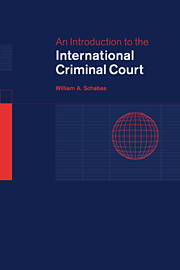Book contents
- Frontmatter
- Contents
- Preface
- List of abbreviations
- 1 Creation of the Court
- 2 Crimes prosecuted by the Court
- 3 Jurisdiction and admissibility
- 4 General principles of criminal law
- 5 Investigation and pre-trial procedure
- 6 Trial and appeal
- 7 Punishment and the rights of victims
- 8 Structure and administration of the Court
- Appendices
- Bibliography
- Index
2 - Crimes prosecuted by the Court
Published online by Cambridge University Press: 05 June 2012
- Frontmatter
- Contents
- Preface
- List of abbreviations
- 1 Creation of the Court
- 2 Crimes prosecuted by the Court
- 3 Jurisdiction and admissibility
- 4 General principles of criminal law
- 5 Investigation and pre-trial procedure
- 6 Trial and appeal
- 7 Punishment and the rights of victims
- 8 Structure and administration of the Court
- Appendices
- Bibliography
- Index
Summary
The International Criminal Court has jurisdiction over four categories of crimes: genocide, crimes against humanity, war crimes and aggression. In both the preamble to the Statute and in Article 5, these are variously described as ‘the most serious crimes of concern to the international community as a whole’. Elsewhere, the Statute describes them as ‘unimaginable atrocities that deeply shock the conscience of humanity’ (preamble), ‘international crimes’ (preamble), and ‘the most serious crimes of international concern’ (Article 1).
The concept of ‘international crimes’ has been around for centuries. They were generally considered to be offences whose repression compelled some international dimension. Piracy, for example, was committed on the high seas. This feature of the crime necessitated special jurisdictional rules as well as cooperation between States. Similar requirements obtained with respect to the slave trade, trafficking in women and children, traffic in narcotic drugs, hijacking, terrorism and money laundering. It was indeed this sort of crime that inspired Trinidad and Tobago, in 1989, to reactivate the issue of an international criminal court within the General Assembly of the United Nations. Crimes of this type are already addressed in a rather sophisticated scheme of international treaties, and for this reason the drafters of the Rome Statute referred to them as ‘treaty crimes’.
The crimes over which the International Criminal Court has jurisdiction are ‘international’ not so much because international cooperation is needed for their repression, although this is also true, but because their heinous nature elevates them to a level where they are of ‘concern’ to the international community. These crimes are somewhat more recent in origin than many of the so-called ‘treaty crimes’, in that their recognition and subsequent development is closely associated with the human rights movement that arose subsequent to World War II.
- Type
- Chapter
- Information
- An Introduction to the International Criminal Court , pp. 21 - 53Publisher: Cambridge University PressPrint publication year: 2001
- 1
- Cited by

